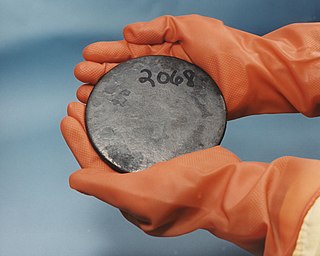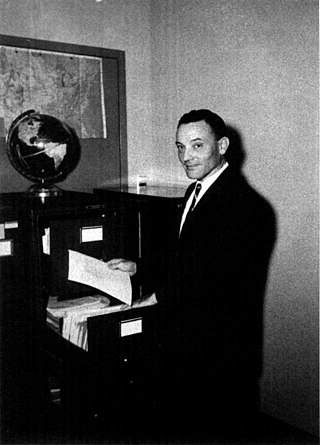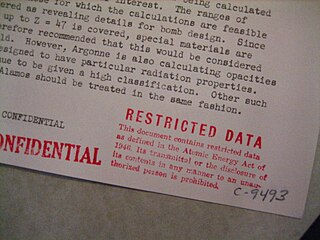
Los Alamos National Laboratory is one of the sixteen research and development laboratories of the United States Department of Energy (DOE), located a short distance northwest of Santa Fe, New Mexico, in the American southwest. Best known for its central role in helping develop the first atomic bomb, LANL is one of the world's largest and most advanced scientific institutions.

Classified information is material that a government body deems to be sensitive information that must be protected. Access is restricted by law or regulation to particular groups of people with the necessary security clearance and need to know. Mishandling of the material can incur criminal penalties.
A security clearance is a status granted to individuals allowing them access to classified information or to restricted areas, after completion of a thorough background check. The term "security clearance" is also sometimes used in private organizations that have a formal process to vet employees for access to sensitive information. A clearance by itself is normally not sufficient to gain access; the organization must also determine that the cleared individual needs to know specific information. No individual is supposed to be granted automatic access to classified information solely because of rank, position, or a security clearance.

Idaho National Laboratory (INL) is one of the national laboratories of the United States Department of Energy and is managed by the Battelle Energy Alliance. Historically, the lab has been involved with nuclear research, although the laboratory does other research as well. Much of current knowledge about how nuclear reactors behave and misbehave was discovered at what is now Idaho National Laboratory. John Grossenbacher, former INL director, said, "The history of nuclear energy for peaceful application has principally been written in Idaho".

United States of America v. Progressive, Inc., Erwin Knoll, Samuel Day, Jr., and Howard Morland, 467 F. Supp. 990, was a lawsuit brought against The Progressive magazine by the United States Department of Energy (DOE) in 1979. A temporary injunction was granted against The Progressive to prevent the publication of an article written by activist Howard Morland that purported to reveal the "secret" of the hydrogen bomb. Though the information had been compiled from publicly available sources, the DOE claimed that it fell under the "born secret" clause of the Atomic Energy Act of 1954.
"Born secret" and "born classified" are both terms which refer to a policy under the system of law in the United States of information being classified from the moment of its inception, usually regardless of where it was created, and usually in reference to specific laws in the United States that are related to information that describes the operation of nuclear weapons. The concept is not limited to nuclear weapons, and other ideas and technologies may be considered as born secret under law. There are no other areas of United States law where it is illegal to discuss publicly-available information. In 2006, the United States Department of Energy themselves noted that the born secret/classified doctrine was controversial.
Critical Nuclear Weapon Design Information is a U.S. Department of Defense (DoD) category of Top Secret Restricted Data or Secret Restricted Data that reveals the theory of operation or design of the components of a thermonuclear or fission bomb, warhead, demolition munition, or test device. Specifically excluded is information concerning arming, fuzing, and firing systems; limited life components; and total contained quantities of fissionable, fusionable, and high explosive materials by type. Among these excluded items are the components that DoD personnel set, maintain, operate, test or replace. The sensitivity of DoD CNWDI is such that access is granted to the absolute minimum number of employees who require it for the accomplishment of assigned responsibilities on a classified contract. Because of the importance of such information, special requirements have been established for its control.

Special nuclear material (SNM) is a term used by the United States Nuclear Regulatory Commission to classify fissile materials. The NRC divides special nuclear material into three main categories, according to the risk and potential for its direct use in a clandestine nuclear weapon or for its use in the production of nuclear material for use in a nuclear weapon.

Richard Greening Hewlett was an American public historian best known for his work as the Chief Historian of the United States Atomic Energy Commission.
The United States government classification system is established under Executive Order 13526, the latest in a long series of executive orders on the topic of classified information beginning in 1951. Issued by President Barack Obama in 2009, Executive Order 13526 replaced earlier executive orders on the topic and modified the regulations codified to 32 C.F.R. 2001. It lays out the system of classification, declassification, and handling of national security information generated by the U.S. government and its employees and contractors, as well as information received from other governments.
The timeline of the Cox Report controversy is a chronology of information relating to the People's Republic of China's (PRC) nuclear espionage against the United States detailed in the Congressional Cox Report. The timeline also includes documented information relating to relevant investigations and reactions by the White House, the U.S. Congress, the Federal Bureau of Investigation (FBI), and United States Department of Justice.

Q clearance or Q access authorization is the U.S. Department of Energy (DOE) security clearance required to access Top Secret Restricted Data, Formerly Restricted Data, and National Security Information, as well as Secret Restricted Data. Restricted Data (RD) is defined in the Atomic Energy Act of 1954 and covers nuclear weapons and related materials. The lower-level L clearance is sufficient for access to Secret Formerly Restricted Data (FRD) and National Security Information, as well as Confidential Restricted Data and Formerly Restricted Data. Access to Restricted Data is only granted on a need-to-know basis to personnel with appropriate clearances.
Classified information in the United Kingdom is a system used to protect information from intentional or inadvertent release to unauthorised readers. The system is organised by the Cabinet Office and is implemented throughout central and local government and critical national infrastructure. The system is also used by private sector bodies that provide services to the public sector.

Information sensitivity is the control of access to information or knowledge that might result in loss of an advantage or level of security if disclosed to others. Loss, misuse, modification, or unauthorized access to sensitive information can adversely affect the privacy or welfare of an individual, trade secrets of a business or even the security and international relations of a nation depending on the level of sensitivity and nature of the information.
A Single Scope Background Investigation (SSBI), now called a Tier 5 (T5) investigation, is a type of United States security clearance investigation. It involves investigators or agents interviewing past employers, coworkers and other individuals associated with the subject of the SSBI. It is governed by the U.S. Intelligence Community Policy Guidance Number 704.1.
The Office of Secure Transportation (OST) is a highly-specialized law enforcement division of the National Nuclear Security Administration within the United States Department of Energy. The OST's mission is to provide safe and secure transportation of nuclear weapons and components and special nuclear materials and conduct other missions in support of U.S. national security.

The Office of Intelligence and Counterintelligence is an office of the United States Department of Energy (DOE) responsible for all intelligence and counterintelligence activities throughout the DOE complex. It was established in 2006 by the merger of pre-existing Energy Department intelligence and security organizations. Due to its central role, OICI is designated DOE's Headquarters Intelligence. As a component of the United States Intelligence Community in addition to the Department of Energy, OICI reports to both the Director of National Intelligence and Secretary of Energy.

Restricted Data (RD) is a category of proscribed information, per National Industrial Security Program Operating Manual (NISPOM). Specifically, it is defined by the Atomic Energy Act of 1954 as:
Right to know is a human right enshrined in law in several countries. UNESCO defines it as the right for people to "participate in an informed way in decisions that affect them, while also holding governments and others accountable". It pursues universal access to information as essential foundation of inclusive knowledge societies. It is often defined in the context of the right for people to know about their potential exposure to environmental conditions or substances that may cause illness or injury, but it can also refer more generally to freedom of information or informed consent.









